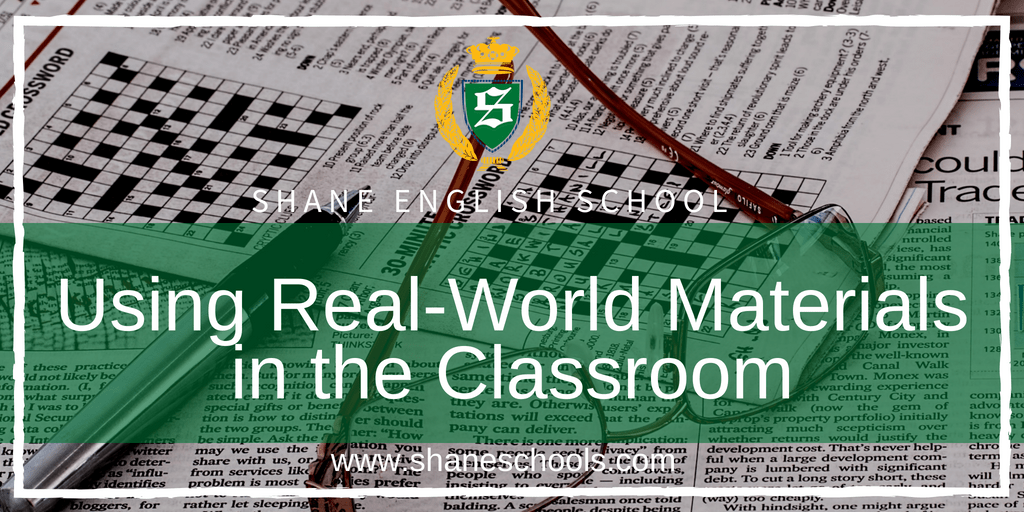I love using real-world materials when teaching English. Authentic materials are plenty and easy to find. Whether it is news articles for reading lessons, realia (real-life objects) to make learning new vocabulary more memorable or playing the latest hit song for listening practice, including real-world examples has many benefits.
For some ideas on how to use music in your English lessons, check out our blog post on the subject.
Why might you want to use real-world materials in your classroom?
Real-life examples help to accustom your students to how the language is really used out of the classroom. Think of how a real conversation between native-speakers might differ from a pre-recorded dialogue. A real conversation will likely be faster, less clear or perfect and have more filler words and sounds than a scripted chat. By exposing your students to real-life examples, you are preparing them for what’s out there.
While textbooks, language recordings and other pre-prepared teaching resources are tremendously helpful, they are not always readily available. If you find yourself teaching at a school with limited resources, you will have to prepare most of the teaching materials yourself. This is where real-world materials will truly be indispensable. The internet might be the first place you’d consider when looking for teaching resources, but there are alternatives. A local tourist information center might have information brochures available in English, certain products could have English labels, some restaurants might have English menus and a nearby museum or a historic site might have English information signs. You could even involve your students by asking them to look out for authentic English texts and bring them to class. You could then plan a lesson based on the materials your students provided.
Real-world materials are also worth considering if the context of the teaching materials you do have is not very relevant or interesting to your students. If you are teaching a group of Korean teenagers, they might enjoy talking about Big Bang or BTS more than Yoko Ono and John Lennon. If you are teaching adults or older teenagers, a lesson on CV writing might be very useful and appreciated. There’s an informative video on the topic available online if you do decide to help your students with their CVs. Knowing your students interests and reasons for learning English will help you decide what real-word examples to center your lesson around and make your lessons more personal.
Real-world Tasks to Try with your Students
Photographs and comic strips from newspapers can make fabulous real-world teaching resources. If you are looking for a writing lesson, you could ask your students to write a serious and a humorous caption for each of the photos. Similarly, you could bring in comic strips with blanked out speech bubbles and ask your students to fill them in. Then let the students wander around the classroom to read the captions and comic strips of others. Towards the end of the activity, you could show the students the original captions and comic strips.
For a speaking activity involving photos, pick a big and detailed photograph and cut it into as many pieces as there are students in your classroom. Give one piece of the photo to each student and get them to describe what is on their piece, without showing it, to others. Only once a student finds another student whose piece, they are sure, is adjacent to theirs should they show their pieces to each other. The objective is for the students to reconstruct the picture based on the descriptions of the individual pieces. You could then have a group conversation with your students about what is happening in the photograph.
You can base a fun reading and speaking lesson on restaurant menus. Give your students time to familiarize themselves with the menus. If the dishes in the menu are accompanied by a description, you could cover the dish names and get your students to guess what the dish is based on the description. For example, ‘bread dipped in egg and cinnamon batter and fried till golden brown’ is French Toast. For a latter part of the lesson, divide your students into ‘guests’ and ‘waiters’ and get them to practice the dialogue, get the ‘waiter’ to check the order with the ‘guest’. You could try to collect some menus from local establishments to make thing a bit more personal.
Field trips and lessons outside can be very memorable and enjoyable for both children and adult students alike. If your school allows it, consider taking your students out of the classroom and teaching them English in the real world. You could take them to a museum, library or an art gallery, window-shopping, to a zoo or a park, a café or an ice-cream parlour to name but a few possible destinations. If your school is in a remote location, take your students on a short nature walk and teach them the English names of the plants and animals and other surroundings. Such outdoor lessons are also great if you would like to try your hand at Content and Language Integrated Learning (CLIL) methodology.
Want more like this? Visit our Teaching Tips blog and check out our Language Learning Tips. What are your thoughts on using real-world examples in your classroom? Please share with us on Facebook or Twitter.
About the Author
Aleks Kaye completed a blended CELTA course, while working full-time in Student Support at a university in the UK. She is currently spending a year in Canada with her husband David. You can read about their adventures at daleksabroad.travel.blog

We're hiring!
With schools around the world, Shane English School always has exciting new opportunities to offer.


